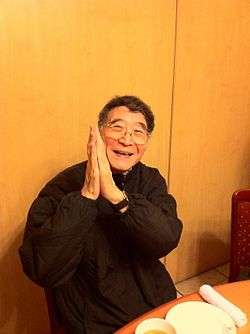Han Pao-teh
| Han Pao-teh 漢寶德 | |
|---|---|
 | |
| Born |
19 August 1934 Shantung |
| Died |
20 November 2014 (aged 80) Taipei, Taiwan |
| Nationality | Republic of China |
| Alma mater |
Tainan Institute of Technology Harvard University Princeton University |
| Occupation | Architect |
| Awards | Executive Yuan Culture Award |
Han Pao-teh (Chinese: 漢寶德; pinyin: Hàn Bǎodé; 19 August 1934 – 20 November 2014) was a Taiwanese architect, educator and curator.
Han Pao-teh was born and raised in Shandong, China and moved to Taiwan in 1952. In 1958, he graduated in architecture from Tainan Institute of Technology, now known as the National Cheng Kung University.[1] He was awarded a scholarship to Harvard University in the United States for a master's degree in architecture in 1965 and then also gained an MA degree at Princeton University in 1967.
He returned to Taiwan in 1967, where he lectured as the head of the Department of Architecture at Tunghai University in Taichung. He left Tunghai in 1977 to be Dean of the College of Science and Engineering at National Chung Hsing University. He was one of the architects who played a role in the preservation of historic structures, including the Lin Family Mansion in Banqiao.[2]
During 1981–1986, Han Pao-teh was appointed by the Executive Yuan to lead the preparation for the establishment of National Museum of Natural Science, the first modern museum in Taiwan, where he was also appointed by the Ministry of Education the first Director from 1987 to 1995. In 1993, Han Pao-teh was also appointed to establish Tainan National University of the Arts (TNNUA), where he was also selected to be the first president of TNNUA and the program chair of the graduate school of Museum Studies in 1996. Shortly after his retirement from TNNUA in 2000, Han Pao-teh was invited by the Ling Jiou Mountain Buddhist Foundation to be the first curator of the Museum of World Religions. During 1998–2001, he was also the director of National Culture and Arts Foundation. Han Pao-teh has been appointed the Geheimrat of Presidential Office in Taiwan since 2001.
Han Pao-teh died in Taipei, Taiwan, on 20 November 2014. He was posthumously given the Executive Yuan Culture Award, the nation's highest cultural award.[3]
Han is commemorated in the scientific name of a species of Vietnamese lizard, Takydromus hani.[4]
Works of architecture
Buildings designed by Han Pao-teh include:
- Tiansiang Youth Activity Center (1978), Taroko Gorge, Hualien County
- Cultural Center (1981), Changhua County
- Institute of Ethnology (1985), Academia Sinica
- Tainan National University of the Arts (1996)
- Nan Yuan (1985) - Jiangnan-style architecture and landscaped gardens in Hsinpu, Hsinchu County, was for many years a very exclusive area for the use of top-echelon officers of the United Daily News (UDN).[5]
Major publications
- Han Pao-Teh, Han Pao-Teh's Narrative about Cultures, Artouch, 2006. ISBN 986-7519-84-1.
- Han Pao-Teh, A Walk in European Architectures, Ecus Publishing House, 2005.
- Han Pao-Teh, The Memoir of Han Pao-Teh, Book Zoom, 2004. ISBN 957-621-909-4.
- Han Pao-Teh, Han Pao-Teh's Narrative about Aestheticism, Linkingbooks, 2004. ISBN 957-08-2703-3.
- Han Pao-Teh, Expatiating on Architecture, Hebei Education Press, 2003. ISBN 7-5434-5034-8.
- Han Pao-Teh, Looking into Architecture, Artbook, 2002. ISBN 986-7957-40-7.
- Han Pao-Teh, Exhibition Planning: Theory and Practice, Archi, 2000. ISBN 957-8440-98-7.
- Han Pao-Teh, Recent Reflections on Architecture and Culture, National Museum of History, 1995. ISBN 957-00-5923-0.
- Han Pao-Teh, The Story of Chinese Landscape Design: External Forms and Internal Visions, Art Media Resources, Ltd., 1992. ISBN 978-957-530-356-3.
- Han Pao-Teh, Museum Management, Garden City Publishers, 1990. ISBN 957-8440-96-0.
- Han Pao-Teh, The Spiritual Dimensions of Architecture, Architecture Informations, 1971. ISBN 957-0454-31-8.
- Han Pao-Teh, Architecture, Society and Culture, Architecture Informations, 1971. ISBN 957-0454-11-3.
External links
| Wikimedia Commons has media related to Han Pao-teh. |
- Han Pao-teh at the archINFORM database
References
- ↑ Kelly Her (November 2007). "A Postmodern Traditionalist". Taiwan Today. Vol. 57 no. 11.
- ↑ Dingbo Wu (1994). Handbook of Chinese Popular Culture. Greenwood Publishing Group. pp. 341–. ISBN 978-0-313-27808-2.
- ↑ "Executive Yuan honors contributors to national culture". Taipei Times. 26 November 2014. Retrieved 26 December 2016.
- ↑ Beolens, Bo; Watkins, Michael; Grayson, Michael (2011). The Eponym Dictionary of Reptiles. Baltimore: Johns Hopkins University Press. xiii + 296 pp. ISBN 978-1-4214-0135-5. ("Han", p. 115).
- ↑ "Archived copy". Archived from the original on 2013-08-24. Retrieved 2013-06-29.